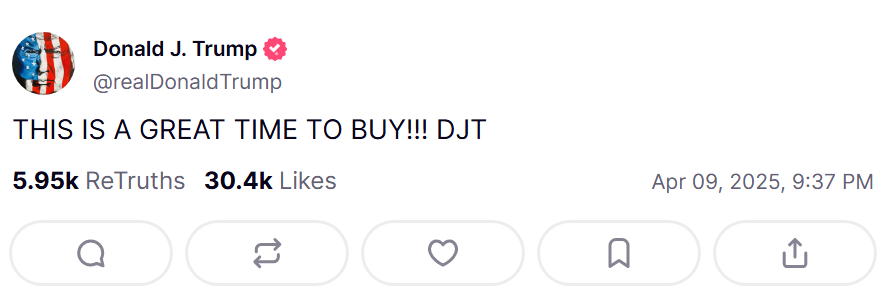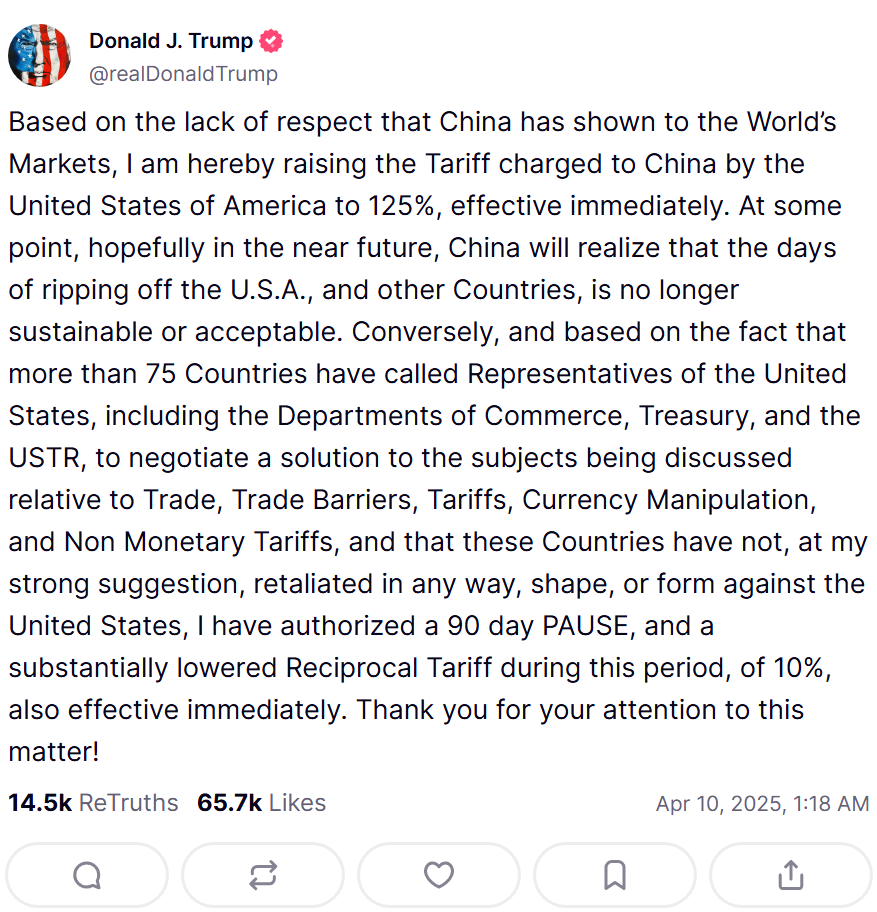NOT how markets are supposed to work! Welcome to Trump’s “new normal” investors
If you’ve just woken from a coma, rolled over, and opened the stocks app on your phone to check your portfolio (I know that’s the first thing I’d do), then you probably would have received a substantial surprise.
The market just did what!? (slips back into coma!)
I am of course referring to the massive gyrations in markets over the last 6 weeks – largely due to just one man. Genius deal maker or financial markets terrorist? Love him or hate him, President Trump is moving markets like no other single individual has ever done before.
The 12.2% gain in the Nasdaq Composite Wednesday was the second largest in history – only pipped by the 14.2% gain on January 3, 2001, which followed a surprise rate cut from the Fed amidst the depths of the Dot-com bear market.
Wednesday’s gains came as investors rejoiced at President Trump’s announcement that he would pause for 90 days many of his “reciprocal” tariffs announced on April 2.
Here’s a quick summary of everything you need to know regarding the latest developments:
Tariff Pause Announced: 90-day pause on most "reciprocal" tariffs, reducing them to a universal 10% rate, effective immediately, except for China. The pause applies to tariffs on over 75 countries that did not retaliate, lowering rates from highs like 50% (e.g., on Lesotho!) to 10% for 90 days.
China Tariffs Escalated: Tariffs on Chinese imports were raised to 125% from 104%, effective immediately, due to China’s perceived "lack of respect" and its 84% retaliatory tariffs on US goods. Further, the 90-day pause does not apply to China, intensifying the US-China trade war.
Market Chaos: Markets plunged over 12% since April 2’s “Liberation Day” announcement of President Trump’s reciprocal tariffs, but soared Wednesday after the announcement of the conditional pause, with the S&P 500 up 9.5% and Nasdaq up 12.2% – their biggest one-day gains since 2008 and 2001, respectively.
External Pressure: Trump acknowledged market turmoil, stating, “People were getting yippy, a little bit afraid,” suggesting surges in bond yields and stock losses influenced his decision. After the announcement, Trump was quoted as saying “The bond market now is beautiful”.
Internal Pressure: Treasury Secretary Scott Bessent reportedly convinced Trump to focus on China while pausing others, framing it as a strategic move planned after a Sunday talk, despite earlier denials of market-driven shifts. There are also rumours that Bessent’s threat to resign unless Trump moderated his stance on tariffs helped force the President’s hand.
Administration disarray, policy changes on the hop: During a House Ways and Means Committee US Trade Representative Jamieson Greer faced a challenging moment that underscored apparent disarray within the Trump administration. While testifying to defend the administration’s aggressive tariff strategy – Greer was caught off guard, seemingly unawares of President Trump’s backflip!
Global retaliation is still inbound: The EU approved 25% tariffs on U.S. goods (effective next week), and China’s 84% duties began April 10, adding pressure before Trump’s reversal.
Other Policy Changes: Trump signed an executive order on Wednesday to lift water pressure restrictions for showerheads (Hey – still relevant – shares in the manufacturer of the Commando 450 just went ballistic 🚀!).
Not how markets are supposed to work!
So, this is where markets are at: Swinging on the whims of one person, who, to be fair, has a history of changing his mind as he sees fit. If he sees a better path to a better outcome, Trump has no qualms in pursuing it to score what he perceives as a win.
But, even if he scores a win eventually – this is not how markets are supposed to work. Markets exist to price risk, a mechanism honed throughout history to balance supply, demand, and uncertainty. When risks emerge – sometimes abruptly, like COVID-19 crashing global economies in weeks, or gradually, like the sub-prime mortgage crisis brewing over years prior to the GFC – markets do their work and adjust.
Markets can’t do their work when fiscal policy decisions critical to the global economy, and therefore the pricing of risk, are made on the fly.
Your honour, I present Exhibit A:

At 9:37 AM EDT, a few hours before announcing the paring back of his reciprocal tariffs, President Trump tweeted "THIS IS A GREAT TIME TO BUY!!! DJT".
And now, please consider Exhibit B:

This second post served as the initial public disclosure of the policy shift – forget press conferences at the White House…It seems we’re now doing major, globally important, market moving policy announcements via a social media platform related to the President of the United States!
Further, the incredulity of the timing gap is staggering, that is, how a figure who holds a position of such high regard could effectively pre-signal a seismic policy shift – which would so obviously have ramifications for asset prices.
That idea, that the President of the United States could telegraph such a seismic reversal and therefore potentially enrich insiders while markets reeled from prior tariff chaos, defies belief. It also highlights the unpredictable nature of this administration’s actions on markets.
Arguably, the market isn’t pricing risk anymore: It’s chasing headlines. And this makes it difficult for both fundamental analysts, and technical analysts, like me.
The damage that’s so far still to be undone – Have markets jumped the gun? 🤔
Despite the rally, economists are warning of ongoing risks from the China trade war and the still-remaining 10% baseline tariff. So, the following uncertainties linger, potentially set to continue to haunt US trade partners, financial markets, and weary investors:
China Trade War Escalation: 125% tariffs on China (and Beijing’s 84% retaliatory duties already in effect) signal a prolonged standoff between the world’s two biggest economies and superpowers and will undoubtedly disrupt supply chains.
90-Day Pause Fragility: The temporary reprieve offers no guarantee – tariffs could snap back with a social media post, but to be fair, could also ease further, or disappear completely!
Market Volatility: A 12% Nasdaq surge masks underlying jitters. There were already rumours of hedge funds going to the wall due to recent volatility (likely highly leveraged, long-based momentum funds), but Wednesday’s move could decimate hedge funds who were heavily positioned on the short side. If funds do go under, investors will suffer directly, but also potentially indirectly, as we discover which financial institutions were exposed to those funds. Write-downs, insolvencies, mistrust in the creditworthiness of key players – all the stuff consistent with historic major market meltdowns!
Baseline Tariff Burden: The 10% universal tariff persists, squeezing importers and consumers alike. The prospect for higher inflation in the US, and negative impacts to US corporate profits remain. Firms like Walmart, Delta Air Lines, FedEx, GM, and Pandora have each forecast major hits to earnings due to Trump administration trade policy – albeit markets have adjusted the perceived reduced impact on stock prices with Wednesday’s move.
Trust Deficit: Trump’s erratic moves – tweets to policy flip-flops – erode confidence in US stability. The US’s biggest trade partners no doubt have their nose at least somewhat out of joint. They’re undoubtedly planning new ways to reduce their dependence on the US as a trade partner, but potentially also as a destination for their investments. This could have substantial ramifications for the US dollar as a global reserve currency and for US Treasuries as a global reserve risk-free asset.
Trump’s tariff backflip key takeaways
Clearly, there are just as many unanswered questions today after Wednesday's shenanigans as there were prior to them. Markets are doing their best to reprice the new risk landscape (or perceived diminishing of it).
For me, this highlights the importance of never being all in or all out. Some market commentators recently espoused the benefits of an all-cash capital allocation. The events of the last 24-hours demonstrate why this can be a dangerous position, and not the perceived “safe” position one might think.
If markets can swing so wildly both ways, there are risks in being both overinvested and underinvested. Perhaps then, a balanced approach, potentially using a mix of stocks, bonds, and cash (perhaps with a sprinkling of short-side exposure) may prove to be the best approach in Trump’s "new normal".
This article first appeared on Market Index on Thursday 10 April 2025.
5 topics
9 stocks mentioned

